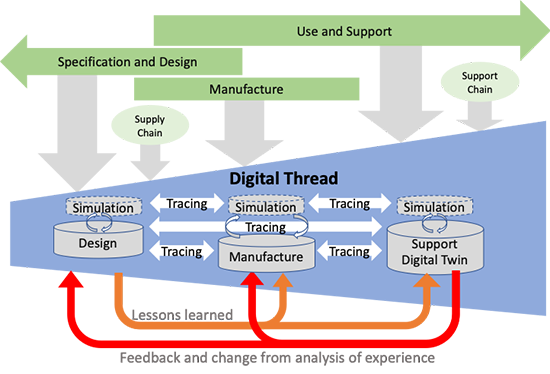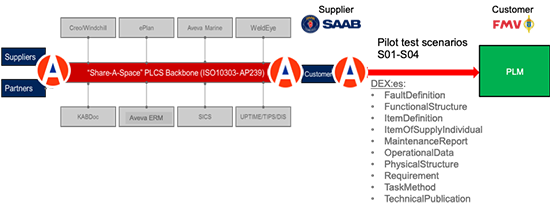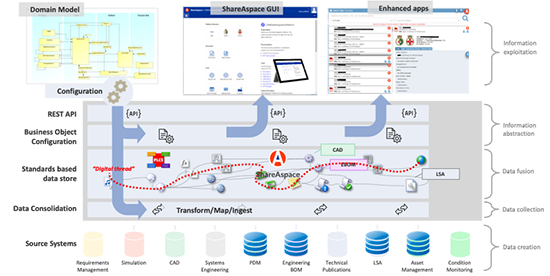Key takeaways:
- Managing the product lifecycle today involves many tools, often with their own data and use cases, that add significant complexity to managing lifecycle information across global value chains.
- Capturing and managing the content and relationships among information that spans the product lifecycle from idea through life is essential to maintaining a digital thread and traceability through life.
- Long-lived products and their digital thread often outlive the applications used to develop them (or even the enterprises involved), raising the importance of using a standards-based approach, specifically those standards designed to support cross-enterprise sharing across the product lifecycle.
- ShareAspace, an extended enterprise collaboration solution from Eurostep, was built around just those standards and has proven successes in multiple industries and lifecycle scenarios.
Introduction
For as long as there have been products, those products have had a lifecycle. They were conceived, created, sold, supported, and retired long before the advent of digital tools. Today that lifecycle is supported by a plethora of digital tools, each generating intellectual property that must be captured and managed as part of a digital thread spanning from idea through life. That management problem is hard enough within a company, but today’s global value chains make it even more difficult. Creating robust data definition and exchange standards can help address this problem, and a global community worked together to define the ISO 10303 suite of standards, known as STEP, that is collectively intended to do just that. Eurostep built their business model and solutions on taking a standards-based approach to solving this common problem. Their solution, ShareAspace, has been successfully used to support collaborative development and lifecycle support in a range of industries. Their ability to capture and manage a collaboratively developed and supported digital thread is the focus of this commentary.[1]
Capturing the Digital Thread Across a Global Value Chain
Since the advent of Industry 3.0, digital computing technologies have been applied to the product and process lifecycle in a variety of ways. Early days saw two-dimensional mechanical computer-aided design (2D MCAD) evolve to 3D. Cheap computing power made computer-aided engineering (CAE) feasible and now commonplace. More recently, the emergence and rapid growth of social computing applications and the Internet of Things (IoT) brought even more data that must be considered during the lifecycle. And these are just a few of many types of applications regularly employed in industry. These applications and use cases generate a range of data that must be managed to support the product lifecycle.
CIMdata owes its existence (and name) to the advent of Industry 3.0, also often referred to as the emergence of computer-integrated manufacturing (CIM). We have chronicled the evolution of the application of digital technologies to the product lifecycle since the early 1980s. In the early 2000s CIMdata and the industry converged on the concept of product lifecycle management (PLM), which CIMdata sees as a strategic business approach enabled by a set of digital technologies. Since the emergence of PLM, CIMdata has discussed the bill of information, a virtual data store for information associated with the product lifecycle from idea through life––CAD files, BOMs, documents, visualization/markup, CAM files, etc., including the interrelationships among them. PLM has always been about managing this wide range of information, associated to the evolving product and its lifecycle, in an extremely heterogeneous tool environment.
Today, the phrase “digital thread” has taken hold in a range of industries to describe much the same idea. CIMdata defines the digital thread as a communication framework that allows a connected data flow and integrated view of an asset’s data (i.e., its Digital Twin) throughout its lifecycle across traditionally siloed functional domains. The phrase digital twin is also widely used but definitions vary widely. What each solution provider means by the phrase varies, mainly as a function of their current offerings and strategies. CIMdata’s preferred definition of the digital twin is a virtual representation (i.e., digital surrogate) of a physical asset or collection of physical assets (i.e., physical twin) that exploits data flow to/from the associated physical asset(s). In a smart, connected world, products can report detailed information on their current status and recent use, information that can be invaluable to maintain overall equipment effectiveness (OEE) or, increasingly, to optimize future product designs based on real world data.
Capturing this set of data and process information is an extremely complex problem. The digital thread definition talks about a communications framework for sharing that information across design, manufacturing, and deployment. How should such a framework best be defined? Eurostep and their many satisfied customers believe that a standards-based definition is the best approach. Eurostep built their business and solutions around this approach, including their flagship offering, ShareAspace.
Eurostep ShareAspace: Hub for the Digital Thread
Eurostep is well-known for their work on standards that enable product data exchange and collaboration. Founded in 1994, Eurostep has been a key proponent of openness and standards, with a focus on ISO 10303, formally known as “Automation systems and integration — Product data representation and exchange,” but better known as STEP, the Standard for the Exchange of Product model data. STEP Application Protocol 242 (AP 242 or ISO 10303-242) defines “managed model-based 3D engineering,” dictating how 3D content is to be shared. In the PLM context, ISO 10303-239, the Product Life Cycle Support (PLCS) standard, is equally important as it defines “what information can be exchanged and represented to support a product through life.” In today’s parlance, PLCS helps capture the digital thread. Eurostep’s work on standard data formats and structures to support global collaboration has been core to their mission. In 2001 Eurostep introduced ShareAspace, the first value chain collaboration solution built around data exchange standards like ISO 10303, ISO 10303-239, and ISO 10303-214/242.
It is important to note that the ISO 10303-239 PLCS development process was driven by leading industrial companies and supported by the solution providers and government bodies such as Ministries of Defense. Leading industrial firms like Boeing, BAE Systems, Lockheed Martin, Rolls-Royce, and Saab, together with their customers, wanted to ensure that their combined information needs could be met. Solution and service providers were also involved, representing a range of application areas including PLM, enterprise resource planning (ERP), enterprise asset management (EAM), and maintenance, repair and overhaul (MRO).
Eurostep takes a very broad view of the digital thread, reflected in the range of business problems addressed by ShareAspace illustrated in Figure 1 Most complex designs are collaborative efforts between a prime contractor or original equipment manufacturer (OEM) and their supply chain partners. These collaborations generate a lot of information about the evolving design and the associated manufacturing processes that must be captured as part of the digital thread that will help animate digital twins. Many of the use cases Eurostep supports are for extremely long-lived products with complex support requirements, e.g., military aircraft and ships. Rightfully, custodians of these long-lived products have concerns about data preservation for long-term use. There is concern about intellectual property being locked in the data format of providers and systems that are likely not to be around for the asset’s lifetime. Again, this demonstrates the importance of data format standards in helping to meet these lifecycle support requirements.

Figure 1—ShareAspace Support for the Digital Thread
(Courtesy of Eurostep)
Eurostep has an impressive list of customers using ShareAspace as the collaboration hub to support a range of lifecycle use cases, from collaborative development to aftermarket support. Making this work requires a strong set of business arrangements, supported by process and information standards to ensure the digital thread information is complete for all upstream and downstream usages.
Saab Kockums (Kockums), a shipyard in Sweden known for military shipbuilding, used ShareAspace to implement a very broad lifecycle vision that also includes using PLCS DEXs (Data Exchange Specification) to communicate with their main customer. Saab deployed ShareAspace as the product data backbone as well as a collaboration hub for suppliers, partners, and customers to enable model-based product development. In a recent presentation, Mr. Torbjörn Pettersson, IT Director for Kockums, spoke of the complexities of maintaining point-to-point integrations in a traditional PLM environment. In model-based development, different tools describe requirements, functional models, logical models, and physical/3D models, making it difficult to define and maintain the complex relationships among those views. Kockums decided that a better approach would be to focus on the data, developing a concept model that semantically defined the knowledge domains that would be shared by different organizations over the product lifecycle. This concept model and its mapping would then help define the necessary integrations. Figure 2 illustrates this concept in practice for how Kockums is using ShareAspace as the backbone and to support their end customer, the Swedish Defence Materiel Administration (FMV). It includes integrations between ShareAspace and commercial tools like Creo, Windchill, EPLAN, and AVEVA Marine, with the data and process requirements defined by a set of DEXs. Work on building out this complex environment is on-going.

Figure 2—FMV Suppliers Use the ShareAspace Information Backbone
(Courtesy of Eurostep)
BAE Systems, a leading UK defense contractor, is implementing an equally expansive lifecycle vision, in this case for the Queen Elizabeth-class aircraft carriers. The new ships were developed by the Aircraft Carrier Alliance (ACA), a partnership between BAE Systems, Babcock International, the Thales Group, and the UK Ministry of Defence (MOD) to build these carriers for the Royal Navy. At the PI PLMX event in London in 2019, Mr. Roger Hobley, Technology Development Manager for BAE Systems Maritime Services, emphasized that the MOD is the end user for his work, not his colleagues at BAE Systems. The Royal Navy’s new flagship has an expansive mission that must be delivered at 1/3 to 1/5 of the cost of her nearest rival (the Gerald Ford-class carrier from the United States). The timelines are also very aggressive. This required assembling an “all-star” team working at multiple shipyards to make their vision a reality. Both carriers—the HMS Queen Elizabeth and her sister ship the HMS Prince of Wales—have been delivered and commissioned in the Royal Navy, an impressive feat of engineering and complex, multi-site manufacturing. With the development program complete, the Aircraft Carrier Alliance is being closed down. This presents a major challenge: preserving the design data as part of the digital thread for the carriers and keeping it current and accessible for lifetime support.
Supporting the carriers requires the active participation from a distributed support chain from across the MOD and industry. Each partner and their respective value chains have their own development processes and tools. BAE Systems have built a solution to help manage the design intent through life. The goal is to deliver “assured product support information (APSI)” to the customer, in this case the MOD. The focus was not on the individual tools but on the information needed to provide that assurance to the customer. BAE Systems sees their work with their ACA partners and Eurostep as founded in a shared belief in the power of standards, enabled by a customer champion in the MOD. The project remained focused on the needed information and less focused on tools, an uncommon approach. This is important, as data is converging from over 165 different systems. ShareAspace provides the common data integration platform that spans the lifecycle, gathering information from tools used in design through to maintenance management, as shown in Figure 3.

Figure 3—Architecture Supporting the Queen Elizabeth-Class Carriers Program
(Courtesy of Eurostep)
CIMdata was impressed with the use of ShareAspace in this complex application. This standards-based information architecture is now proven as readily achievable, with the right combination of technology, people, and strong leadership, a combination this program has enjoyed. Their approach preserves the digital thread across the potential divide between development and support, a complex endeavor many programs struggle to achieve. CIMdata looks forward to future updates on progress over the early years of the program when the information architecture and business processes will be tested as the carriers execute their missions and need effective lifetime support.
Conclusion
In today’s smart connected world, it is essential for product companies to be able to capture and manage a digital thread of information on product and process development that spans from idea through life. Capturing this information from complex global value chains and managing relationships is extremely challenging. The tool environment can be heterogeneous in the extreme, with data coming from global sources.
Over the last twenty-five years, the global standards community, driven mainly by large industrial firms, produced the STEP family of standards that collectively define the data needed to build a digital thread to support the full lifecycle. Eurostep remains active in the ISO 10303 standards process and built their business on supporting its development and use with their flagship ShareAspace collaboration solution. The company has an impressive range of customers in a variety of industries that are committed to using ShareAspace as their backbone and/or collaboration hub for product lifecycle support. Most parties in these collaborations have their own internal PLM-related tools and infrastructure but can readily provide the necessary information mapped to the ISO standards by integrating with ShareAspace. This is an effective approach that recognizes the heterogenous reality of most value networks and PLM implementations today. Its success to date supporting a wide range of collaborative enterprises is also impressive. ShareAspace is the collaboration hub for large complex projects for long-lived assets like the Queen Elizabeth-class aircraft carriers, down to focused applications like building an after-market support business at a going concern who needed to build their digital thread to help make that business feasible and profitable. The common thread, if you will, is the commitment to product data standards as the means to ensure open and maintainable information, something that is in the DNA of Eurostep.




